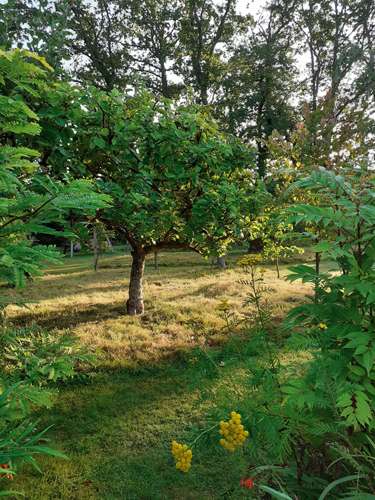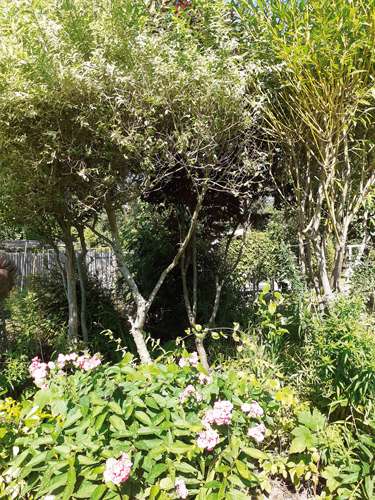
Firstly, I just wanted to mention the blight that hit most of our tomatoes and potatoes grown outdoors this year. It is a disease caused by a fungus-like organism that spreads rapidly on the air, into the foliage and tubers or fruit of potatoes and tomatoes in wet weather, causing collapse and decay and there seems to be nothing that we can do to protect these two crops, other than growing the tomatoes in a greenhouse. I lost all the plants that were growing out in the veggie beds but the blight only affected the tomato plant that was growing nearest to the door of the greenhouse and the others are all still producing very tasty, if rather small fruits. The good news is that crops of tomatoes can be grown again in the pots and soil that was used this year, which is a bit of a relief!
Now the next part of this article is about light and balance! I captured this picture early in the morning, with the sunlight shining through an apple tree, with wonderful glimpses of the wild garden beyond that has just been strimmed.
October is the time for pruning larger trees and bushes. As we have had limited sunlight this year a lot of shrubs and trees have put on a huge amount of growth as they reach towards the light – the Botanical term for this is etiolation. This has meant that I am having to prune another 2m off some of the taller specimens of willows even though they have been cut back fairly severely twice already this year! The roots of Salix (willow) reach right down to the water table very quickly, which is why they can put on such a growth spurt. This has affected one particular area in the garden, when normally there is a wonderful view through the flower bed to the garden beyond but this is how it looked a month ago and as you can see the willows were totally overgrown and causing the flowering plants to grow taller than usual and often collapsing.
After attacking the willows with a saw and loppers, the ‘borrowed vision’ of the garden beyond has been revealed, looking towards the house this time. So, by pruning the trees and larger shrubs you can create different perspectives and views of other parts of the garden. This also restores the balance and shape, reduces the strain on the plant and allows it to rest over the winter months. Roses also need to be cut hard back, cutting just above a leaf or branch at a 45% angle away from the leaf node, to allow any rain to run off down the stem.
So, on to dividing and moving perennials if you are not too exhausted! There are often bargain plants to be ‘sold off’ at nurseries in early October and these can be split into 2 or more plants, potted into good compost and then planted into the garden later in the month in clumps of 3 or 5. Hardy perennials such as asters, phlox, leucojum and rudbeckia can be lifted and split into smaller clumps, by cutting down through the root ball with a sharp spade. They then need to be replanted again in groups of 3 or 5 in holes twice the size the root ball in good compost, so they become well established before winter really sets in. After tidying up the flowerbeds, I always give the flower beds a good application of good compost, to enrich the soil ready for next year.
After this there are just the bulbs to plant, greenhouse to clean, etc…! October is seen as the end of a gardener’s year, when we can sit and plan for the next growing season.
Have fun in your garden.













